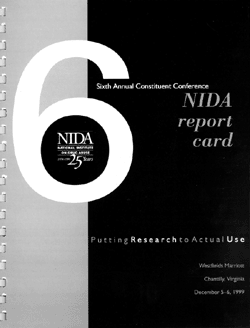As part of the program at each NIDA Constituent Conference, representatives of national groups in the field of drug abuse recommend to NIDA staff the research, outreach, and collaborative activities that they think the Institute should undertake in the coming year. At the next constituent conference, NIDA reports its actions in response to constituent input. This detailed list of activities is the NIDA "Report Card."

NIDA's 1999 Report Card, presented at the 6th Constituent Conference in December in Chantilly, Virginia, lists almost 250 activities that address constituent recommendations. A sample of these activities is listed below:
- NIDA, the National Cancer Institute, and the Robert Wood Johnson Foundation are jointly sponsoring a nationwide initiative to establish Transdisciplinary Tobacco Use Research Centers (TTURCs) to study tobacco use and develop new ways to combat it and its consequences. In October, seven academic institutions were awarded 5-year grants to establish TTURCs: Brown University in Providence, Rhode Island; the University of California, Irvine; the University of Southern California in Los Angeles; Georgetown University in Washington, D.C.; the University of Minnesota in Minneapolis; the University of Wisconsin in Madison; and Yale University in New Haven, Connecticut.
- NIDA awarded grants to create the first Regional Research Treatment Centers (RRTCs) in the National Drug Abuse Treatment Clinical Trials Network. Ultimately, 20 to 30 RRTCs will operate in the network, each linked to 10 to 15 community-based treatment programs that represent a variety of treatment settings and patient populations. Institutions receiving awards in September were Yale University in New Haven, Connecticut; the University of Pennsylvania in Philadelphia; The Johns Hopkins University in Baltimore; the Medical College of Virginia in Richmond; the University of California, Los Angeles; and the Oregon Health Sciences University in Portland.
- In conjunction with the National Institute of Child Health and Human Development, NIDA is releasing a Request for Applications to address problems fundamental to understanding the action of drugs in children. Expanding understanding of pediatric pharmacology will enhance efforts to prevent and treat drug addiction among children and adolescents.
- NIDA and the Entertainment Industries Council presented the second annual PRISM Awards in Beverly Hills, California, in March 1999. The awards recognize outstanding efforts by the entertainment industry to accurately depict drug abuse and addiction in films, television, and videos.
- In September, NIDA celebrated its 25th anniversary at the National Institutes of Health (NIH) in Bethesda, Maryland, with a day-long symposium and public event: "NIDA: Celebrating a Quarter Century of Scientific Progress." The event highlighted some of NIDA's past, present, and anticipated accomplishments in research on drug abuse and addiction.
- NIDA initiated the "Buprenorphine Best Practices Study" that is being conducted in six States. The study will follow 600 patients and evaluate opiate abuse treatment using a buprenorphine-naloxone combination in nontraditional treatment settings.
- NIDA coordinated "Neuroimaging: Glimpses into the Working Brain," the NIH's main neuroscience event to recognize Brain Awareness Week. Eleven NIH institutes participated in the March event, which included a session for scientists on the use of sophisticated brain imaging technologies and sessions for the public on how drugs and stress affect the brain and language and spatial abilities.
- In October 1999, NIDA published Principles of Drug Addiction Treatment, the first science-based guide to effective drug addiction treatment. The brochure outlines some of the essential components of drug addiction and its treatment based on more than 30 years of scientific research.
